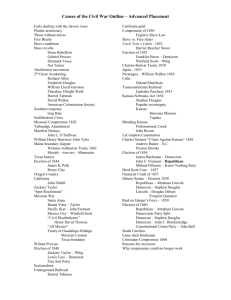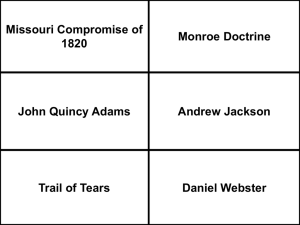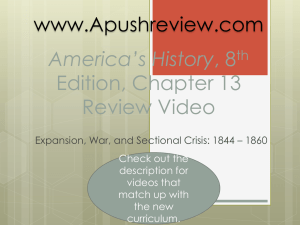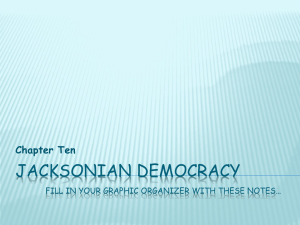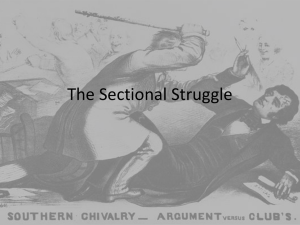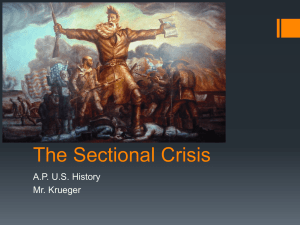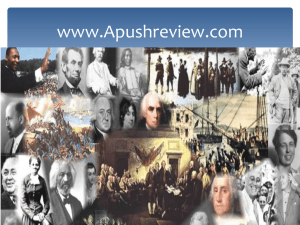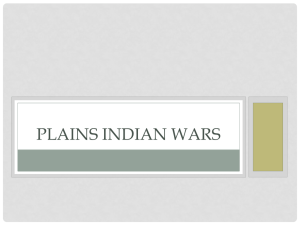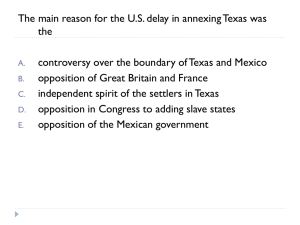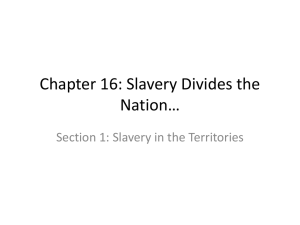2014 AP US HISTORY
advertisement
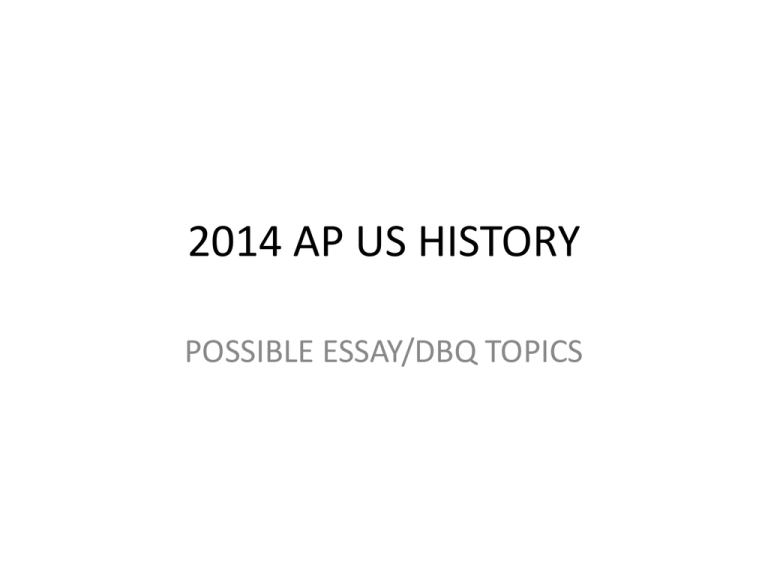
2014 AP US HISTORY POSSIBLE ESSAY/DBQ TOPICS Pre-Civil War Race Relations/Slavery/Racism, PART I Early incidents- Jamestown, Sugar Islands, Triangular Trade, Middle Passage, Bacon’s Rebellion.. Southern justifications/apologists vs abolitionists/ emancipationists-Bible, Aristotle, economic/social justifications, African slavery, England, indentured servants, cash crops, Headright system. (All explain the “peculiar institution”) Abolitionism- starts with 2nd Great Awakening, underground RR, Harriet Tubman, racial unrest in the North (esp. the Irish). Garrison, The Liberator, Douglas, Sojourner Truth, Broadcloth Mob, nullifies fugitive slave law, UTC., Free-Soil Party and Republican Party. Slavocracy- King Cotton, Whitney- cotton gin, 1 out of 5 actually owned slaves, rest hoped to, harsher slave codes, Nat Turner’s Rebellion- no more emancipation talk, Impending Crisis of the South- Helper’s book, South’s #1 defense- it’s in the Constitution. Post Civil War Race Relations/Reconstruction/Civil Rights, PART II Three plans of Reconstruction- Lincoln(10%), Johnson, Radical Wade-Davis Bill- 50% loyalty, pocket vetoed by Lincoln Freedman’s bureau- 1st welfare system for former slaves, “40 acres and a mule” Slave codes/Black codes/Jim Crow laws-apartheid/segregation in South until 1960s Redeemer governments-white former Confederates back in charge. 13th free, 14th citizens, and 15th vote Recon. amendments, Civil Rights Act of 1868 scalawags, carpetbaggers, rise of KKK, anti-black, Catholic, Jew etc. Literacy test, poll tax, grandfather clause to block voting rights. Sharecropping, tenant farming, economic struggles… Andrew Johnson’s impeachment- Tenure of Office Act, Sen. Edmund Ross saved him Strange Life of Jim Crow by Woodward, Up from Slavery by Washington, WEB DuBois Election of 1876 and Compromise of 1877- ends Reconstruction, leads to New South (new textile industries) Plessy v Ferguson “separate but equal” 1896, Brown v Board “inherently unequal” 1954 CRA, VRA, Civil Rights Movement, MLK, SCLC, Rosa Parks, Black Panthers, violent vs non-violent, SNCC, Malcolm X, Stokely Carmichael, Lyndon B. Johnson, Montgomery Bus boycott, March on Washington, Freedom Summer Southern resistance- Ole Miss, Little Rock, Univ Alabama, KKK, Freedom Riders, Bombingham, Women’s Rights Movement Anne Hutchinson, Halfway Covenant, “cult of domesticity” Abigail Adams-”don’t forget the ladies”, Stanton, Dix, Susan B. Anthony, Jane Addams, Mott, Woodhall Seneca Falls Convention- Declaration of Sentiments- “all men and women”, 1st major women's’ movement meeting. Post Civil War- same issues, but better organized… 19th amendment- “Anthony’s amendment” Cult of domesticity/Republican Mothers- good wives and mothers 2nd Great Awakening, Abolitionist movement, temperance, reform movements of all kinds Sacrifice during the nations’ wars, gained more educational, work and social opportunities, teaching 1st profession Grimke sisters- abolitionism and women’s education, southerners Margaret Sanger- Birth control, the pill, sexual revolution, Mueller v. Oregon, Triangle Shirtwaist fire, sweatshop conditions WWII-Rosie the Riveter, June Cleaverism of the 1950s, ERA Movement of the 1970s, National Organization for Women(NOW) Betty Friedan- The Feminine Mystique-”is that all there is”. Native American Relations Chesapeake (exclusive) -New England (exclusive) Jamestown- 1607 -Puritans and Separatist later “Pilgrims” Powhatan Indians/Pocahantas, tobacco -constant expansion onto native land Indentured servants, 1619 slaves -King Phillip’s War/Metacomet atrocities 1676 Looking for gold, imposing on land -NE Confederation Tobacco led to expansion of farms -25% casualities, highest death % of any US war “Starving Time”- John Smith -Indians are devil’s own people….. Bacon’s Rebellion -last major N.A. event in N.E. Spanish in SW US -Pilgrims- Thanksgiving, Samoset Slavery of the Indians -Mystic massacre 1630’s Columbian exchange- trade w/Europe -Hutchinson/Williams (R.I) dissenters 1630’s Small pox/diseases --”invented grandparents” Encomenidas- plantations, land Missionaries/conquistadors New Amsterdam/New York/France Goes from exclusive to inclusive, intermarriage-fur trade, partners, Inclusive from the start -intermarriage, diversity, equality under France/Dutch Purchase of Manhattan from the Indians by the French -1st owned by the Dutch, taken over by the Br. in 1666 -good relations with the Indians More Native Background: Jamestown, King Phillips War, Pontiac’s Rebellion, Tecumseh, Treaty of Greenville, warhawks Post Civil War Indian Wars 1864-1890, pop. Spreading west in the Plains Indian tribes Indian Removal Act, Cherokee, Trail of Tears- early forms of removal out west Turner Thesis, Century of Dishonor- Helen Hunt Jackson Battle of Little Bighorn, George Armstrong Custer, Battle of Wounded Knee (Sitting Bull, Crazy Horse-Sioux) Chief Joseph, Geronimo, Gen Philip Sheridan-”The only good Indian is a dead Indian”, Brown’s book, I buried my heart at Wounded Knee. Decimation of buffalo, placing Indians on reservations, starvation sets in… Zinn- treatment of Indians is all about racism by whites Dawes Act (1888)- assimilation of the Indians, failed Indian New Deal in 1934- help square things during the Great Depression. - Steps to American Unity/Lack of • Major steps of Colonial unification- New England confederation, Dominion of New England, 1st Great Awakening, Albany Plan of Union-Iroquois, French-Indian War- fight for the mother country. • Unite against taxation –Proc. of 1763, Stamp Act, Townshend Act, Sons of Liberty, Boston Tea Party, The Association, Dec. of Ind., Common Sense, “no taxation w/o representation, boycotts, committees of correspondence…… • Colonies coming to together when a common goal arises but after the war, problems with the Articles, acting independently of each other, disunity.. • War of 1812- patriotism and nationalism, icons • Introduction of Nullification and Succession- not just Southern words • North- Embargo, Hartford Con, nullify Fugitive Slave Law, Webster • South- Va/Ken Resolutions, SC Null. Crisis, Comp of 1850, J.C. Calhoun, Election of 1860 • Compromises- Constitution, Missouri, Tariff, Compromise of 1850, Crittenden Compromise • End of unity- Civil War, Reconstruction, 2 Americas, N and So. • Class warfare- growing difference between rich and poor • Black and White, Native and non-native, young and old, liberal and conservative Isolationism/Neutrality- Between the Wars Washington Neutrality proclamation, GW Farewell Address Embargo Act of 1807, Monroe Doctrine “War to end all wars”, “War to save democracy”- W. Wilson Lodge and the Reservationists- Wilson kills his own treaty. Fourteen points League of Nations/League Covenant/Article X- US doesn’t join, very weak and lacks power. US to blame? “Return to Normalcy”- President Harding Red Scare, part I/ Palmer Raids KKK/Sacco and Vanzetti/anti-foreigner sentiments Kellogg-Briand Pact/Dawes Plan Appeasement/Munich Conference London Economic Conference/domestic concerns/Great Depression- US stays isolated Neutrality Acts of 1935-37/abandoned China and Spain/no trade with any country at war, gave up our right to Freedom of the Seas Panay Incident/Rape of Nanking/embargo on Japan “Send guns not suns”- FDR Lend Lease(garden hose)/cash-n-carry/destroyers for bases- economic declaration of war on Germany Ended with the Fall of France and the Japanese attack of Pearl Harbor Broken at times: Sp/Am war, Mex/Am war…. Imperialism/International Trade and Affairs • • • • • • • • • • • • • • • • The colonists are now becoming the colonizers… Starts Nationalistic, Patriotic and Jingoistic movements worldwide... American exports boomed and needed new markets.. Strong’s book Our Country and Mahan’s book Sea Power Great Rapprochement , repaired our relationship with Britain. Hawaii, Pearl Harbor, the McKinley Tariff virtually shut off sugar exports to the US and white planters such as Dole/US army were spurred to action…. Overthrew Queen Lili and Hawaii became a republic until annexed 1898.. Cuban “insurrectos” fighting against the Spanish dictator known as the “Butcher Weiler” were threatening American investments and were sensationalized in the “yellow” press. USS Maine, it mysteriously blew up killing 260 sailors. Teller Amend. makes Cuba independent. Platt amendment- allows intervention in Cuba. T. Roosevelt, “Rough Riders”, a lot of problems for the army, but navy shined in this war. Dewey, Battle of Manila Bay, Battle of San Juan Hill The Treaty of Paris 1898 gave to the US Cuba, P.R., Guam and Wake Is. and the Philippines, $20 million Pres. McKinley reluctant to keep Philipines / chose to “civilize and Christianize the natives”. The Anti-Imperialist League, led by Mark Twain, Andrew Carnegie and Samuel Gompers Filipino rebellion led by Aguinaldo “guerilla war”, water torture and concentration camps, “benevolent assimilation” of the Filipinos in education, infrastructure etc….. In the 1901 Insular Cases, the Sup. Ct. ruled that the Const. does not necessarily provide rights to these new citizens or “follow the flag”…... Rise of the Common Man/TJ-AH/ Jacksonian Democracy • Reread your paper/DBQ on TJ-AH and changing constructionism, look over TJ/AH slide in Unit 3… • Rise of the common man, universal manhood suffrage, DPDF, popular war hero, AJ changes the power of the presidency • Corrupt Bargain, Henry Clay, JQ Adams • Election/Revolution of 1828, nasty election, Rachel dies, wants revenge using presidency to get it • Spoils system, rotation system • Peggy Eaton Affair, cabinet resigns (including VP Calhoun), kitchen cabinet, uses veto more than all presidents combined, including Maysville Road • Three major issues: The BUS, Nullification Crisis, and the Indians • BUS: Nicholas Biddle, pet banks, tool of the rich and wealthy, rejected its renewal by AJ, election of 1832, beats Clay • Nullification Crisis: South Carolina, Black Tariff of Abominations, Calhoun, Compromise Tariff, Force Bill, AJ threatens invasion, South believes tariff too high, stabbed in the back by the North • Indians: Indian Removal Act of 1830, Cherokee, Cherokee vs Georgia, John Marshall, Trail of Tears, AJ believes they can’t coexist • Changes the power of the presidency Countdown to Civil War/Debate over the expansion of slavery west • Failure to compromise / flaws in the Constitution • California gold rush, 49ers, application for statehood (free or slave?) • Compromise of 1850-Clay, Calhoun, Webster (7th of March-”no peaceful succession”) • 4 parts of the comp.- Cal free, tough fugitive slave law, Tx debt, no slave trade in DC • Massachusetts “nullies”- North refuses to enforce fug. Slave law • Kansas-Nebraska Act- Stephen Douglas • Uncle Tom’s Cabin, Impending Crisis of the South, “Ain’t I a woman”, underground railroad-Harriet Tubman • Bleeding Kansas- New. Eng. Emigrant –”Beecher’s bibles” to Kansas • Election of 1856- Republican Party-doesn’t have to win in the South…. • Dredd Scot- “obiter dictum”, slaves are property can not use courts • Crash of 1857- South unhurt economically, belief in “King Cotton” • Lincoln-Douglas debates- Freeport Doctrine • Harper’s Ferry- John Brown, South begins to prepare for war • Election of 1860- Lincoln wins over Douglas and others, only wins northern states • Succession of S.C.- faked it in 1833, now its real, other states quickly follow, C.S.A formed 11 states 2 territories • Fort Sumter- first shots fired Articles of Confederation/Constitution • • • • • • • • • • • • • • • • • Newburgh Conspiracy failed, a post war recession, Continental dollars/state currencies were worthless States began to bicker about $ as well as western land claims England dumped cheap goods on the newly reopened US markets and destroyed US industries The 2nd Continental Congress adopted the 1st plan of Gov’t for the new US in 1777 the Articles of Confederation. Weakenessess: only 1 branch of govt, legislature could only ask for donations, states had just one vote, most votes required a 2/3 majority…no solutions for the post war problems.. Article Strengths: they worked fairly well of the common goal to win the war, they held the country together. Negotiated the Treaty of Alliance with France and the Treaty of Paris 1783, were stepping stone from the Association to the Constitution, learned what not to do the next time. The Land of Ordinance provided for the distribution of western lands and the NW Ordinance outlined the 3 step process for a territory to become a state States bickered over commerce laws, donations to the Fed Govt, western lands It soon became clear to many that the Articles needed to be amended or replaced Daniel Shays’ Rebellion was the turning point, Fed Govt seemed helpless to deal with it Annapolis Conference, need to “amend the articles” , Miracle at Philadelphia- Bowen GW president of the convention, JM-”Father of the Constitution”, Virginia and New Jersey Plans Compromises- Great Compromise (representation in Congress), 3/5 compromise, slave trade, ratification, and electoral college. Roger Sherman, Ben Franklin, Alexander Hamiliton Constitution- seperation of powers, delegated and reserved powers, branches of government, strong central government Federalists- supporters of the Con, Federalist Papers- written by JM,JJ, AH, Madison’s #10-important Anti-Federalists- opposed the Con, wanted a Bill of Rights added to protect individual liberites, wanted strong state goverments, believed a strong central govt would be like the British King A revolution, this time peaceful, engineered by a small group of conservative white, changed the course of US History • • • • • • • • • • • • • • • Populism/Progressivism/Unionism Sherman Silver Act of 1890, “artificial inflation” demanded by debtors such as farmers, the McKinley tariff. Bimetallism- ^ $ supply to pay off debts The movement was especially strong in Kansas, the Midwest and in the South The Populist gained support as millions of farmers joined their ranks Attacked “special interest”, RR, Banks, Industry and other “enemies of the people”, they clamored for reforms, wishing to reform the system Mary Lease , “ raise less corn and raise more hell”, “Wall Street” Panic of 1893, massive depression brought many supporters to the party Need labor union/immigrant factory workers votes, anti-public Pushed for minimum wage, 8 hr work day, direction election of senators, secret ballot, income tax, govt regulation of big business Coin’s Financial School, William Hope Harvey, “silverites” vs“gold bugs”, William Jennings Bryan, Cross of Gold Speech, William McKinley, Election of 1896. Populists died, but their ideas were kept alive by the Progressive Movement, led by the muckrakers, women, Teddy Roosevelt, Taft, and Wilson Ida Tarbell- Reckafella, didn’t offer solutions Many issues: trusts, govt corruption, alcoholism, women/child labor, poverty, slums, business corruption, primaries, eliminate pol. Machines.. 16th, 17th, 18th, 19th amendments Triangle Shirtwaist Co. fire, sweatshops, Muller vs Oregon, WCTU. Trustbusting, Square Deal, 3 C’s, Sherman and Clayton Anti-Trust Acts, Underwood Tariff Louis Brandies Other People’s Money- Fed Reserve and Upton Sinclair’s The Jungle-FDA • • • • • Economic, Social, and Political turmoil from 1960-1980 Presidencies of Kennedy, Johnson, Nixon, Ford, Carter, Reagan. DOES NOT INCLUDE CIVIL RIGHTS…… Economic: Great Society, Guns-n-Butter, Vietnam Warincrease of military spending, 50s consumerism, Stagflation, OPEC Embargo/Energy Crisis, Clean Air/Water, Three Mile Island Social: Counterculture/Silent Majority, Silent Spring, The Other America, Roe vs Wade, Rise of Conservatismfundamental Christians, Kent State Massacre, decline of labor unions/middle class industrial jobs, anti-war crowd, 50s conformity Political: JFK/RFK/MLK assassinations, Vietnam War, Gulf of Tonkin Incident, Tet Offensive, Miranda case, Nixon’s détente with USSR/China, Iran hostage crisis, USSR invasion of Afghanistan, Watergate, SALT I and II. Other potential essay topics by Unit • • • • • • • • • • • • Unit 1: Colonial ESP, early Colonial Unity (pre Rev War) Unit 2: Rev War as a social reformer (women, blacks, Indians), mercantilism Unit 3: American System Unit 4: Reform movement, women Unit 5: Slavery, Manifest Destiny Unit 6: Strengths and weaknesses of the North and South, strategy, choices Lincoln and Davis had before Ft. Sumter, Eman. Proc. Unit 7: Populism, Imperialism Unit 8: TR (Foreign and Domestic Policies) and the modern presidency, Wilson and the Triple Wall of Privilege, causes of WW I, Progressivism Unit 9: Causes of the Depression, economic boom of the 20s, New Deal Unit 10: Origins of the Cold War, Truman’s decision to drop the A-Bomb Unit 11: Cold War, McCarthyism, consumerism and culture of the 50s, counterculture movement Unit 12: Vietnam to Watergate to Carter: decline of American power.
